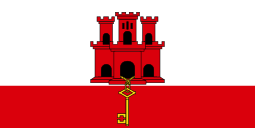Gibraltar
| Gibraltar |
||||||
|---|---|---|---|---|---|---|
|
||||||
| Motto: "Montis Insignia Calpe" (Latin) "Badge of the Rock of Gibraltar"[1] |
||||||
| Anthem: "God Save the Queen" (official) "Gibraltar Anthem" (local)[2] |
||||||
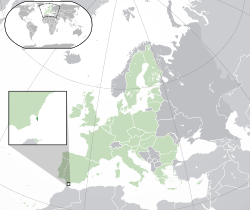 Location of Gibraltar (dark green) – in Europe (green & dark grey) |
||||||
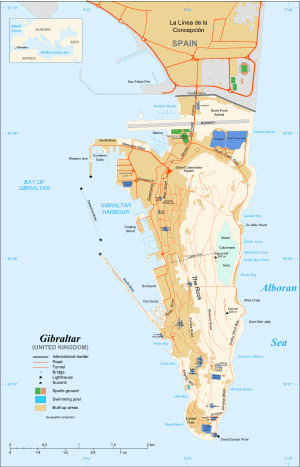 Map of Gibraltar
|
||||||
| Status | British Overseas Territory | |||||
| Capital | Gibraltar 36°8′N 5°21′W / 36.133°N 5.350°W | |||||
| Largest district (by population) |
Westside | |||||
| Official languages | English | |||||
| Spoken languages | ||||||
| Ethnic groups |
|
|||||
| Demonym | Gibraltarian Llanito (colloquial) |
|||||
| Government | Representative democratic parliamentary dependency under constitutional monarchy | |||||
| • | Monarch | Elizabeth II | ||||
| • | Governor | Ed Davis | ||||
| • | Chief Minister | Fabian Picardo | ||||
| Legislature | Parliament | |||||
| Formation | ||||||
| • | Captured | 4 August 1704[3] | ||||
| • | Ceded | 11 April 1713[4] | ||||
| • | National Day | 10 September | ||||
| Area | ||||||
| • | Total | 6.8 km2 (241st) 2.6 sq mi |
||||
| • | Water (%) | 0 | ||||
| Population | ||||||
| • | 2015 estimate | 32,194 (222nd) | ||||
| • | Density | 4,328/km2 (5th) 11,320/sq mi |
||||
| GDP (PPP) | 2013 estimate | |||||
| • | Total | £1.64 billion | ||||
| • | Per capita | £50,941 (n/a) | ||||
| HDI (2015) | 0.861[5] very high · 40th |
|||||
| Currency | Gibraltar pound (£)c (GIP) | |||||
| Time zone | CET (UTC+1) | |||||
| • | Summer (DST) | CEST (UTC+2) | ||||
| Date format | dd/mm/yyyy | |||||
| Drives on the | rightd | |||||
| Calling code | +350e | |||||
| Patron saint | ||||||
| ISO 3166 code | GI | |||||
| Internet TLD | .gif | |||||
| a. | Of mixed Genoese, Maltese, Portuguese and Spanish descent. | |||||
| b. | As a Special Member State territory of the United Kingdom. | |||||
| c. | Coins and sterling notes are issued by the Government of Gibraltar. | |||||
| d. | Unlike all other UK dependencies except the British Indian Ocean Territory, since 16 June 1929. | |||||
| e. | 9567 from Spain before 10 February 2007. | |||||
| f. | The .eu domain is also used, shared with other European Union member states. UK Postcode: GX11 1AA[6] |
|||||
Gibraltar (/dʒᵻˈbrɒltər/ jə-BROL-tər) is a British Overseas Territory located on the southern end of the Iberian Peninsula.[7][8] It has an area of 6.7 km2 (2.6 sq mi) and shares its northern border with Spain. The Rock of Gibraltar is the major landmark of the region. At its foot is a densely populated city area, home to over 30,000 Gibraltarians and other nationalities.[9]
An Anglo-Dutch force captured Gibraltar from Spain in 1704 during the War of the Spanish Succession on behalf of the Habsburg pretender to the Spanish throne. The territory was subsequently ceded to Britain "in perpetuity" under the Treaty of Utrecht in 1713. During World War II it was an important base for the Royal Navy as it controlled the entrance and exit to the Mediterranean Sea, which is only eight miles (13 km) wide at this point. Today Gibraltar's economy is based largely on tourism, online gambling, financial services, and shipping.[10][11]
The sovereignty of Gibraltar is a major point of contention in Anglo-Spanish relations as Spain asserts a claim to the territory.[11] Gibraltarians overwhelmingly rejected proposals for Spanish sovereignty in a 1967 referendum and again in 2002. Under the Gibraltar constitution of 2006, Gibraltar governs its own affairs, though some powers, such as defence and foreign relations, remain the responsibility of the Government of the United Kingdom.
Name
The name Gibraltar is the Spanish derivation of the Arabic name Jabal Ṭāriq (جبل طارق), meaning "Mountain of Tariq". It refers to the Rock of Gibraltar, which was named after the Umayyad general Tariq ibn-Ziyad who led the initial incursion into Iberia in advance of the main Umayyad force in 711 under the command of Umayyad Caliph Al-Walid I. Earlier, it was known as Mons Calpe, a name of Phoenician origin and one of the Pillars of Hercules.[12]
The pronunciation of the name in modern Spanish is [xiβɾalˈtaɾ] (IPA).
History
Early history
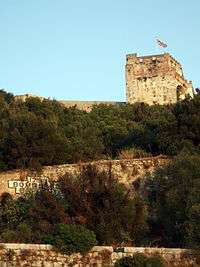
Evidence of Neanderthal habitation in Gibraltar between 28,000 and 24,000 BP has been discovered at Gorham's Cave, making Gibraltar possibly the last known holdout of the Neanderthals.[13] Within recorded history, the first inhabitants were the Phoenicians, around 950 BC. Subsequently, Gibraltar became known as one of the Pillars of Hercules, after the Greek legend of the creation of the Strait of Gibraltar by Heracles. The Carthaginians and Romans also established semi-permanent settlements. After the collapse of the Roman Empire, Gibraltar came briefly under the control of the Vandals.
The area later formed part of the Visigothic Kingdom of Hispania from 414 AD until the Islamic conquest of Iberia in 711 AD.
Settlement
In 1160, the Almohad Sultan Abd al-Mu'min ordered that a permanent settlement, including a castle, be built. It received the name of Medinat al-Fath (City of the Victory).[14] On completion of the works in the town, the Sultan crossed the Strait to look at the works and stayed in Gibraltar for two months. The Tower of Homage of the Moorish Castle remains standing today. From 1274 onwards, the town was fought over and captured by the Nasrids of Granada (in 1237 and 1374), the Marinids of Morocco (in 1274 and 1333) and the kings of Castile (in 1309). In 1462, Gibraltar was finally captured by Juan Alonso de Guzmán, 1st Duke of Medina Sidonia.[15]
After the conquest, King Henry IV of Castile assumed the additional title of King of Gibraltar, establishing it as part of the comarca of the Campo Llano de Gibraltar.[16] Six years later, Gibraltar was restored to the Duke of Medina Sidonia, who sold it in 1474 to a group of 4350 conversos (Christian converts from Judaism) from Cordova and Seville and in exchange for maintaining the garrison of the town for two years, after which time they were expelled, returning to their home towns or moving on to other parts of Spain.[17] In 1501, Gibraltar passed back to the Spanish Crown, and Isabella I of Castile issued a Royal Warrant granting Gibraltar the coat of arms that it still uses today.
In 1704, during the War of the Spanish Succession, a combined Anglo-Dutch fleet, representing the Grand Alliance, captured the town of Gibraltar on behalf of the Archduke Charles of Austria in his campaign to become King of Spain. The occupation of the town by Alliance forces caused the exodus of the population to the surrounding area of the Campo de Gibraltar.[18][19] As the Alliance's campaign faltered, the 1713 Treaty of Utrecht was negotiated and ceded control of Gibraltar to Britain to secure Britain's withdrawal from the war. Unsuccessful attempts by Spanish monarchs to regain Gibraltar were made with the siege of 1727 and again with the Great Siege of Gibraltar (1779 to 1783), during the American War of Independence.
Gibraltar became a key base for the Royal Navy and played an important role prior to the Battle of Trafalgar (21 October 1805) and during the Crimean War of 1854–56, because of its strategic location. Its strategic value increased with the opening of the Suez Canal, as it lay on the sea route between the UK and the British Empire east of Suez. In the later 19th century, there were major investments in improving the fortifications and the port.[20]
Modern history

During World War II, Gibraltar's civilian population was evacuated (mainly to London, England, but also to parts of Morocco, Madeira and Jamaica) and the Rock was strengthened as a fortress. The naval base and the ships based there played a key role in the provisioning and supply of the island of Malta during its long siege. As well as frequent short runs (known as 'Club Runs') towards Malta to fly off aircraft reinforcements (initially Hurricanes but later, notably from the USN aircraft carrier Wasp, Spitfires), the critical Operation Pedestal convoy was run from Gibraltar in August 1942. This resupplied the island at a critical time in the face of concentrated air attacks from German and Italian forces. Spanish dictator Francisco Franco's reluctance to allow the German Army onto Spanish soil frustrated a German plan to capture the Rock, codenamed Operation Felix. In the 1950s, Franco renewed Spain's claim to sovereignty over Gibraltar and restricted movement between Gibraltar and Spain. Gibraltarians voted overwhelmingly to remain under British sovereignty in the Gibraltar sovereignty referendum, 1967, which led to the passing of the Gibraltar Constitution Order in 1969. In response, Spain completely closed the border with Gibraltar and severed all communication links.[21] The border with Spain was partially reopened in 1982 and fully reopened in 1985 before Spain's accession to the European Community.
In a referendum held in 2002, Gibraltarians rejected by an overwhelming majority (98%) a proposal of shared sovereignty on which Spain and Britain were said to have reached "broad agreement".[22][23] The British government has committed itself to respecting the Gibraltarians' wishes.[24] A new Constitution Order was approved in referendum in 2006. A process of tripartite negotiations started in 2006 between Spain, Gibraltar and the UK, ending some restrictions and dealing with disputes in some specific areas such as air movements, customs procedures, telecommunications, pensions and cultural exchange.[25]
The UK's exit from the EU
During the campaign leading up to the United Kingdom's national referendum on whether to leave the European Union (known as "Brexit") the Spanish government warned that if the UK chose to leave, Spain would push to reclaim control over Gibraltar "the very next day".[26]
The Chief Minister of Gibraltar Fabian Picardo warned the UK that if Brexit went ahead Spain could "pounce on us" also stating that "it is safer and more secure for Gibraltar to remain in the EU".[27]
On 23 June 2016 Gibraltar voted with the rest of the United Kingdom on whether the UK should remain in, or leave the European Union. Although the final decision saw the UK decide to leave, Gibraltar overwhelmingly voted to remain in the Union. There was a strong voter turnout of 82% resulting in 19322 votes to remain and only 872 to leave.[28]
The day after the result of the Brexit vote, Spain's acting Foreign Minister José Manuel García-Margallo, as promised, renewed calls for joint Spanish–British control of the peninsula. He labelled the British people's decision to leave the EU as "a complete change of outlook that opens up new possibilities on Gibraltar not seen for a very long time" speculating "the Spanish flag on the Rock is much closer than before".[29]
Governance


Gibraltar is a British overseas territory. The British Nationality Act 1981 granted Gibraltarians full British citizenship.
Under its current constitution, Gibraltar has almost complete internal democratic self-government through an elected parliament,[30][31][32][33] elected for a term of up to four years. The unicameral parliament presently consists of 17 elected members, and the Speaker who is not elected, but appointed by a resolution of the parliament.[34] The government consists of 10 elected members. The head of state is Queen Elizabeth II, who is represented by the Governor of Gibraltar. The governor enacts day-to-day matters on the advice of the Gibraltar Parliament, but is responsible to the British government in respect of defence, foreign policy, internal security and general good governance. Judicial and other appointments are made on behalf of the Queen in consultation with the head of the elected government.[35][36][37][38][39][39][40]
The 2011 election was contested by the Gibraltar Social Democrats (GSD), Gibraltar Socialist Labour Party (GSLP)-Gibraltar Liberal Party (GLP) Alliance and the Progressive Democratic Party (PDP). The PDP is a new party, formed in 2006 and fielded candidates in the 2007 election, but none was elected. The head of government is the Chief Minister (as of December 2011, Fabian Picardo). All local political parties oppose any transfer of sovereignty to Spain, instead supporting self-determination. The main UK opposition parties also support this policy and it is UK government policy not to engage in talks about the sovereignty of Gibraltar without the consent of the people of Gibraltar.[41]
Gibraltar is part of the European Union, having joined through the European Communities Act 1972 (UK), which gave effect to the Treaty of Accession 1972, as a dependent territory of the United Kingdom under what was then article 227(4) of the Treaty Establishing the European Community covering special member state territories, with exemption from some areas such as the Customs union and Common Agricultural Policy. After a 10-year campaign for the right to vote in European elections, since 2004 the people of Gibraltar have participated in elections for the European Parliament as part of the South West England constituency.[42] On 23 June 2016 Gibraltar voted along with the United Kingdom in the EU referendum; 96% of its population voted to remain, but the overall United Kingdom result gave a 51.9% majority to leaving the EU.[43]
Gibraltar was nominated to be included on the United Nations list of Non-Self-Governing Territories by the United Kingdom when the list was created in 1946[44] and has been listed ever since.[45] The government of Gibraltar has actively worked to have Gibraltar removed from the list[46] and in 2008 the UK government declared Gibraltar's continued presence on the list an anachronism.[47]
Geography
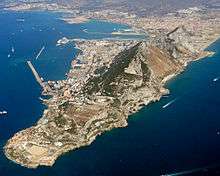
Gibraltar's territory covers 6.8 square kilometres (2.6 sq mi) and shares a 1.2-kilometre (0.75 mi) land border with Spain. The town of La Línea de la Concepción, a municipality of the province of Cádiz, lies on the Spanish side of the border. The Spanish hinterland forms the comarca of Campo de Gibraltar (literally "Countryside of Gibraltar"). The shoreline measures 12 kilometres (7.5 mi) in length. There are two coasts ("Sides") of Gibraltar: the East Side, which contains the settlements of Sandy Bay and Catalan Bay; and the Westside, where the vast majority of the population lives. Gibraltar has no administrative divisions but is divided into seven Major Residential Areas.
Having negligible natural resources and few natural freshwater resources, limited to natural wells in the north, until recently Gibraltar used large concrete and/or natural rock water catchments to collect rainwater. Fresh water from the boreholes is supplemented by two desalination plants: a reverse osmosis plant, constructed in a tunnel within the rock, and a multi-stage flash distillation plant at North Mole.[48]
Gibraltar's terrain consists of the 426-metre-high (1,398 ft) Rock of Gibraltar[49] made of Jurassic limestone, and the narrow coastal lowland surrounding it. It contains many tunnelled roads, most of which are still operated by the military and closed to the general public.
 |
|
 | ||
| |
|
Mediterranean Sea | ||
| ||||
| | ||||
| Strait of Gibraltar; |

Climate
Gibraltar has a subtropical Mediterranean climate (Köppen climate classification Csa),[50][51] with mild winters and warm summers. As is the case for nearby Algeciras and Tarifa, summers are significantly cooler and annual temperature more constant than other cities on the southern coast of the Iberian peninsula because of its position on the Strait of Gibraltar. Rain occurs mainly in winter, with summer being generally dry. Its average annual temperature is about 22 °C (72 °F) during the day and 15 °C (59 °F) at night. In the coldest month, January, the temperature ranges from 11–18 °C (52–64 °F) during the day and 9–14 °C (48–57 °F) at night, the average sea temperature is 15–16 °C (59–61 °F). In the warmest month, August, the typical temperature ranges from 25–31 °C (77–88 °F) during the day, above 20 °C (68 °F) at night, the average sea temperature is 22 °C (72 °F).[52]
| Climate data for Gibraltar | |||||||||||||
|---|---|---|---|---|---|---|---|---|---|---|---|---|---|
| Month | Jan | Feb | Mar | Apr | May | Jun | Jul | Aug | Sep | Oct | Nov | Dec | Year |
| Average high °C (°F) | 15.7 (60.3) |
16.6 (61.9) |
18.4 (65.1) |
20.0 (68) |
22.6 (72.7) |
25.4 (77.7) |
28.1 (82.6) |
28.6 (83.5) |
26.3 (79.3) |
22.9 (73.2) |
19.1 (66.4) |
16.6 (61.9) |
21.7 (71.1) |
| Daily mean °C (°F) | 13.4 (56.1) |
13.8 (56.8) |
15.0 (59) |
16.2 (61.2) |
18.5 (65.3) |
21.1 (70) |
23.7 (74.7) |
24.2 (75.6) |
22.8 (73) |
19.5 (67.1) |
16.1 (61) |
14.1 (57.4) |
18.2 (64.8) |
| Average low °C (°F) | 10.2 (50.4) |
10.7 (51.3) |
12.3 (54.1) |
13.4 (56.1) |
15.4 (59.7) |
18.0 (64.4) |
20.1 (68.2) |
20.8 (69.4) |
19.4 (66.9) |
16.9 (62.4) |
13.9 (57) |
11.4 (52.5) |
15.2 (59.4) |
| Average precipitation mm (inches) | 121 (4.76) |
100 (3.94) |
75 (2.95) |
60 (2.36) |
35 (1.38) |
11 (0.43) |
1 (0.04) |
6 (0.24) |
15 (0.59) |
64 (2.52) |
141 (5.55) |
146 (5.75) |
775 (30.51) |
| Average precipitation days (≥ 1.0 mm) | 8 | 8 | 7 | 7 | 3 | 2 | 0 | 0 | 2 | 5 | 7 | 9 | 60 |
| Mean monthly sunshine hours | 147 | 143 | 204 | 233 | 289 | 319 | 326 | 309 | 240 | 197 | 135 | 134 | 2,676 |
| Source: Deutscher Wetterdienst (sun, 1961–1990)[53][54][nb 1] | |||||||||||||
Flora and fauna
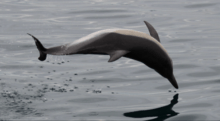
Over 500 different species of flowering plants grow on the Rock. Gibraltar is the only place in Europe where the Gibraltar candytuft (Iberis gibraltarica) is found growing in the wild; the plant is otherwise native to North Africa. It is the symbol of the Upper Rock nature reserve. Olive and pine trees are among the most common of those growing around the Rock.
Most of the Rock's upper area is covered by a nature reserve which is home to around 230 Barbary macaques, the famous "apes" of Gibraltar, which are actually monkeys. These are the only wild apes or monkeys found in Europe.[55] This species, known scientifically as Macaca sylvanus, is listed as endangered by the IUCN Red List and is declining. Three-quarters of the world population live in the Middle Atlas mountains of Morocco. Recent genetic studies and historical documents point to their presence on the Rock before its capture by the British, having possibly been introduced during the Islamic period. A superstition analogous to that of the ravens at the Tower of London states that if the apes ever leave, so will the British. In 1944, British Prime Minister Winston Churchill, was so concerned about the dwindling population of apes that he sent a message to the Colonial Secretary requesting that something be done about the situation.[56]
Other mammals found in Gibraltar include rabbits, foxes and bats. Dolphins and whales are frequently seen in the Bay of Gibraltar. Migrating birds are very common and Gibraltar is home to the only Barbary partridges found on the European continent.
In 1991, Graham Watson, Gibraltar's MEP, highlighted conservationists' fears that urban development, tourism and invasive plant species were threatening Gibraltar's own plants as well as birds and bat species.[57]
Environment
In May 2016 a report by the World Health Organization showed that Gibraltar had the worst air quality in any British territory. The report concentrated on PM10 and PM2.5 pollutants in the air.[58]
Economy

The British military traditionally dominated Gibraltar's economy, with the naval dockyard providing the bulk of economic activity. This, however, has diminished over the last 20 years, and is estimated to account for only 7 percent of the local economy, compared to over 60 percent in 1984. Today, Gibraltar's economy is dominated by four main sectors: financial services, online gambling, shipping, and tourism, which includes retail sales to visitors.[59]
In the early 2000s, many bookmakers and online gaming operators moved to Gibraltar to benefit from operating in a regulated jurisdiction with a favourable corporate tax regime. However, this corporate tax regime for non-resident controlled companies was phased out by January 2011 and replaced by a fixed corporate tax rate of 10 percent.[60]
Tourism is also a significant industry. Gibraltar is a popular port for cruise ships and attracts day visitors from resorts in Spain. The Rock is a popular tourist attraction, particularly among British tourists and residents in the southern coast of Spain. It is also a popular shopping destination, and all goods and services are VAT free, but may be subject to Gibraltar taxes. Many of the large British high street chains have branches or franchises in Gibraltar including Morrisons, Marks & Spencer and Mothercare. Branches and franchises of international retailers such as Tommy Hilfiger and Sunglass Hut are also present in Gibraltar, as is the Spanish clothing company Mango.
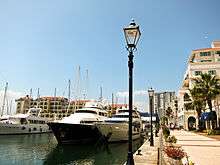
A number of British and international banks have operations based in Gibraltar. Jyske Bank claims to be the oldest bank in the country, based on Jyske's acquisition in 1987 of Banco Galliano, which began operations in Gibraltar in 1855. An ancestor of Barclays, the Anglo-Egyptian Bank, entered in 1888, and Credit Foncier (now Crédit Agricole) entered in 1920.
In 1967, Gibraltar enacted the Companies (Taxation and Concessions) Ordinance (now an Act), which provided for special tax treatment for international business.[61] This was one of the factors leading to the growth of professional services such as private banking and captive insurance management. Gibraltar has several positive attributes as a financial centre, including a common law legal system and access to the EU single market in financial services. The Financial Services Commission (FSC),[62] which was established by an ordinance in 1989 (now an Act) that took effect in 1991, regulates the finance sector.[63] In 1997, the Department of Trade and Industry established its Gibraltar Finance Centre (GFC) Division to facilitate the development the financial sector development. As of 2012, Gibraltar has 0.103 Big Four accounting firm offices per 1,000 population, the second highest in the world after the British Virgin Islands, and 0.6 banks per 1,000 people, the fifth most banks per capita in the world.[64]
The currency of Gibraltar is the Gibraltar pound, issued by the Government of Gibraltar under the terms of the 1934 Currency Notes Act. These banknotes are legal tender in Gibraltar alongside Bank of England banknotes.[65][66] In a currency board arrangement, these notes are issued against reserves of sterling.[66][67][68] Clearing and settlement of funds is conducted in sterling.[69] Coins in circulation follow British denominations but have separate designs. Unofficially, most retail outlets in Gibraltar accept the euro, though some payphones and the Royal Gibraltar Post Office, along with all other government offices, do not.[70]
Demography

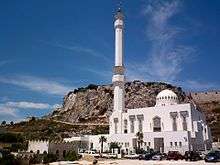
Gibraltar is one of the most densely populated territories in the world, with a usually-resident population in 2012 of 32,194 [71] equivalent to approximately 4,959 inhabitants per square kilometre (12,840/sq mi). The growing demand for space is being increasingly met by land reclamation; reclaimed land currently comprises approximately one tenth of the territory's total area.
Ethnic groups
The demographics of Gibraltar reflect the many European and other economic migrants who came to the Rock over 300 years, after almost all of the Spanish population left in 1704.
Origin of surnames in the electoral roll by percentage is: British (27%), Spanish (26%, mostly Andalusian but also some 2% Minorcan), Genoese and other Italian (15%), Portuguese (15%), and Maltese (8%). There are also small (less than 1%) populations of other groups such as Moroccans, French, Austrians, Chinese, Japanese, Polish and Danish.[72]
| Resident Census | 1981[73] | 1991[73] | 2001[73] | 2012[73] |
|---|---|---|---|---|
| Gibraltarian | 74.87% | 74.98% | 83.22% | 79.03% |
| UK and other British | 14.00% | 14.27% | 9.55% | 13.20% |
| Moroccan | 8.08% | 6.73% | 3.50% | 1.62% |
| Other Nationalities (*) | 3.05% | 4.01% | 3.73% | 6.15% |
| Spanish | – | – | 1.19%[74] | 2.10% |
| Other EU | – | – | 1.00%[74] | 1.61% |
- (*) Includes all nationalities different from Gibraltarian, UK and other British and Moroccan.
Language
The official language of Gibraltar is English, and is used by the government and in schools. Most locals are bilingual, also speaking Spanish, because of Gibraltar's proximity to Spain. However, because of the varied mix of ethnic groups which reside there, other languages are also spoken on the Rock. Berber and Arabic are spoken by the Moroccan community, as are Hindi and Sindhi by the Indian and the Pakistani communities of Gibraltar respectively. Maltese is spoken by some families of Maltese descent. Portuguese is also widely spoken.
Gibraltarians often converse in Llanito (pronounced: [ʎaˈnito]),[75] a vernacular unique to Gibraltar. It is based on Andalusian Spanish with a strong mixture of British English and elements from languages such as Maltese, Portuguese, Genoese Italian and Haketia (a Judeo-Spanish dialect). Llanito also often involves code-switching to English, with technical terms and complex ideas mostly expressed in English.
Gibraltarians often call themselves Llanitos.[76]
Religion
According to the 2012 census, approximately 72.1% of Gibraltarians are Roman Catholics.[77] The 16th century Saint Mary the Crowned is the cathedral church of the Roman Catholic Diocese of Gibraltar, and also the oldest Catholic church in the territory. Other Christian denominations include the Church of England (7.7%), whose Cathedral of the Holy Trinity is the cathedral of the Anglican Bishop of Gibraltar in Europe; the Gibraltar Methodist Church,[78] Church of Scotland, various Pentecostal and independent churches mostly influenced by the House Church and Charismatic movements, as well as a Plymouth Brethren congregation. Several of these congregations are represented by the Gibraltar Evangelical Alliance.
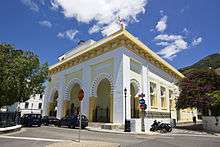
There is also a ward of The Church of Jesus Christ of Latter-day Saints, and two congregations of Jehovah's Witnesses. 7.1% advised that they have no religion. The Gibraltar Secular Humanist Society also holds regular meetings.
The third religion in size is Islam (3.6% of the population). There is also an established Hindu population (2%), members of the Bahá'í Faith and a long-established Jewish community, which, at 763 persons, accounts for 2.4% of the population.[79] As a share of the total population, this is the second-largest Jewish population in the world, trailing only Israel. There are four functioning Orthodox synagogues in Gibraltar and several kosher establishments.
Education
Education in Gibraltar generally follows the English model, operating within a three tier system. Schools in Gibraltar use the Key Stage modular approach to teach the National Curriculum. Gibraltar has 15 state schools, a private school and a college of further education.
On 31 March 2015 the government of Gibraltar announced the adoption of the University of Gibraltar Act and The University of Gibraltar opened in September 2015.[80][81] Previously, there were no facilities in Gibraltar for full-time higher education, and consequently, all Gibraltarian students studied elsewhere at degree level or its equivalent and also for certain non-degree courses.[82] The Government of Gibraltar operates a scholarship/grant system to provide funding for students studying in the United Kingdom. All Gibraltarian students used to follow the UK student loans procedure, applying for a loan from the Student Loans Company which was then reimbursed in full by the Government of Gibraltar. In August 2010, this system was replaced by the direct payment by the government of grants and tuition fees. The overwhelming majority of Gibraltarians continue their studies at university level.
Health care
All Gibraltarians are entitled to health care in public wards and clinics at the St Bernard hospital and primary health care centre. All other British citizens are also entitled to free-of-charge treatment on the Rock on presentation of a valid British passport during stays of up to 30 days. Other EU nationals are equally entitled to treatment on presentation of a valid European Health Insurance Card. Dental treatment and prescribed medicines are free of charge for Gibraltarian students and pensioners.[83]
The Gibraltar Health Authority is funded through the Gibraltar Group Practice Medical Scheme. It employs around 900 people, handling 37,000 A&E attendances, 40,000 outpatient appointments, and 90,000 GP visits a year. Some specialist care is provided by visiting consultants and in UK and Spanish hospitals. First-line medical and nursing services are provided at the Primary Care Centre, which has 16 GPs, with more specialised services available at St Bernard's Hospital, a 210-bed civilian hospital opened in 2005. Psychiatric care is provided by King George V Hospital.
Culture

The culture of Gibraltar reflects Gibraltarians' diverse origins. While there are Spanish (mostly from nearby Andalusia) and British influences, the ethnic origins of most Gibraltarians are not confined to these ethnicities. Other ethnicities include Genoese, Maltese, Portuguese, and German. A few other Gibraltar residents are Jewish of Sephardic origin, Moroccan, or Indians. British influence remains strong, with English being the language of government, commerce, education and the media.
Gibraltar's first sovereignty referendum is celebrated annually on Gibraltar National Day (10 September). It is a public holiday, during which most Gibraltarians dress in their national colours of red and white. Until this year, the tradition had been to also release 30,000 similarly coloured balloons, which represented the people of Gibraltar. However, this tradition has now been ended because of the threat that it poses to wildlife, particularly marine.[84] The 300th anniversary of Gibraltar's capture was celebrated in 2004 on Tercentenary Day (4 August), when in recognition of and with thanks for its long association with Gibraltar, the Royal Navy was given the Freedom of the City of Gibraltar and a human chain of Gibraltarians dressed in red, white and blue, linked hands to encircle the Rock. On 4 June 2012, the Gibraltar Diamond Jubilee Flotilla, inspired by the Thames Diamond Jubilee Pageant, celebrated sixty years of the Queen's reign.[85]
The Gibraltar Broadcasting Corporation operates a television and radio station on UHF, VHF and medium-wave. The radio service is also internet-streamed. Special events and the daily news bulletin are streamed in video. The other local radio service is operated by the British Forces Broadcasting Service which also provides a limited cable television network to HM Forces. The largest and most frequently published newspaper is the Gibraltar Chronicle, Gibraltar's oldest established daily newspaper and the world's second oldest English language newspaper to have been in print continuously[86] with daily editions six days a week. Panorama is published on weekdays, and 7 Days, The New People, and Gibsport are weekly.
_(2).jpg)
Native Gibraltarians have produced some literature of note. The first in fiction was probably Héctor Licudi's 1929 novel Barbarita, written in Spanish,[87] chronicling the largely autobiographical adventures of a young Gibraltarian man. Throughout the 1940s and 1950s, several anthologies of poetry were published by Leopoldo Sanguinetti, Albert Joseph Patron and Alberto Pizzarello. The 1960s were largely dominated by the theatrical works of Elio Cruz and his two highly acclaimed Spanish language plays La Lola se va pá Londre and Connie con cama camera en el comedor. In the 1990s, the Gibraltarian man-of-letters Mario Arroyo published Profiles (1994), a series of bilingual meditations on love, loneliness and death. Of late there have been works by the essayist Mary Chiappe, such as her volume of essays Cabbages and Kings (2006) and by M. G. Sanchez, author of the books Rock Black: Ten Gibraltarian Stories (2008) and Diary of a Victorian Colonial (2009). Mary Chiappe and Sam Benady have also published a series of detective books centred on the character of the nineteenth-century Gibraltarian sleuth Bresciano.
Musicians from Gibraltar include Charles Ramirez, the first guitarist invited to play with the Royal College of Music Orchestra,[88] successful rock bands like Breed 77, Melon Diesel and Taxi, while Gibraltarian bassist Glen Diani played for Irish/British nu metal group One Minute Silence. Albert Hammond had top 10 hits in the UK and US and has written many songs for international artists such as Whitney Houston, Tina Turner and Julio Iglesias.[89]
Gibraltarian cuisine is the result of a long relationship between the Andalusian Spaniards and the British, as well as the many foreigners who made Gibraltar their home over the past three centuries. The culinary influences include those from Malta, Genoa, Portugal, Andalusia and Britain. This marriage of tastes has given Gibraltar an eclectic mix of Mediterranean and British cuisine. Profiteroles, a French choux pastry ball with a sweet filling of whipped cream, is considered to be Gibraltar's national dish. These are often served after a meal including Calentita, a baked bread-like dish made with chickpea flour, water, olive oil, salt and pepper.
Sport

In 2007, there were 18 Gibraltar sports associations with official recognition from their respective international governing bodies. Others have submitted applications for recognition which are being considered. The government supports the many sporting associations financially. Gibraltar also competes in the bi-annual Island Games, which it hosted in 1995.
Football is a popular sport in Gibraltar. The Gibraltar Football Association applied for full membership of UEFA, but their bid was turned down in 2007 in a contentious decision.[90] Gibraltar was confirmed as UEFA's 54th member on 24 May 2013 as a result of Court of Arbitration for Sport (CAS) arbitration and played in Euro 2016 qualifications.[91][92] Their first match was a 0–0 draw against Slovakia. Subsequently, Gibraltar applied for FIFA membership but this bid was also turned down.
On 2 May 2016 the CAS upheld the appeal filed by the Gibraltar Football Association regarding its request to become a full-time member of FIFA. CAS ordered FIFA to stop blocking Gibraltar's application for membership and allow it "without delay".[93]
Cricket enjoys popularity in Gibraltar. The Gibraltar national cricket team won the European Cricket Championship Division Two in 2000 and 2002. Rugby union is fairly popular and one of the fastest growing team sports, Gibraltar Rugby Union Football Union applied for membership of Europe's governing body for rugby. Gibraltar is believed to be the birthplace of the rugby variant Tag Rugby.[94][nb 2]
The Gibraltar Rifle Association (GRA) was Gibraltar's most successful team at the 2009 Island Games, earning four gold medals.
Darts is also a popular sport, with the Gibraltar Darts Association (a full member of World Darts Federation since 1977) running leagues and other regular tournaments. In 2010, Gibraltar hosted and won the Mediterranean Cup, competing against France, Italy, Turkey, Malta and Cyprus.
Communications
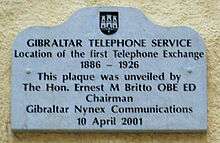

Gibraltar has a digital telephone exchange supported by a fibre optic and copper infrastructure; the telephone operator Gibtelecom also operates a GSM network. Internet connectivity is available across the fixed network. Gibraltar's top-level domain code is .gi.
International Direct Dialling (IDD) is provided, and Gibraltar was allocated the access code +350 by the International Telecommunication Union. This has been universally valid since 10 February 2007, when the telecom dispute was resolved.
Transport

Within Gibraltar, the main form of transport is the car. Motorcycles are also very popular and there is a good modern bus service. Unlike in the UK and other British territories, traffic drives on the right, as the territory shares a land border with Spain.
There is a Gibraltar Cable Car which runs from ground level to the top of the Rock, with an intermediate station at Apes' Den.
Restrictions on transport introduced by Spanish dictator Francisco Franco closed the land frontier in 1969 and also prohibited any air or ferry connections. In 1982, the land border was reopened. As the result of an agreement signed in Córdoba on 18 September 2006 between Gibraltar, the United Kingdom and Spain,[95] the Spanish government agreed to relax border controls at the frontier that have plagued locals for decades; in return, Britain paid increased pensions to Spanish workers who lost their jobs when Franco closed the border.[96] Telecommunication restrictions were lifted in February 2007 and air links with Spain were restored in December 2006.[97][98]
Gibraltar maintains regular flight connections to London, Birmingham and Manchester. Scheduled flights to Morocco and Madrid proved unsustainable because of insufficient demand. Bmibaby started flights from East Midlands Airport to the Rock in March 2012, but the airline closed in September 2012.
GB Airways operated a service between Gibraltar and London and other cities for many years. The airline initially flew under the name "Gibraltar Airways". In 1989, and in anticipation of service to cities outside the UK, Gibraltar Airways changed its name to GB Airways with the belief that a new name would incur fewer political problems. As a franchise, the airline operated flights in full British Airways livery. In 2007, GB Airways was purchased by easyJet,[99] which began operating flights under their name in April 2008 when British Airways re-introduced flights to Gibraltar under their name. Monarch Airlines operates a daily scheduled service between Gibraltar and Luton, London Gatwick Airport, Birmingham and Manchester. It has the largest number of flights between the United Kingdom and Gibraltar. The Spanish national airline, Iberia, operated a daily service to Madrid which ceased for lack of demand. In May 2009, Ándalus Líneas Aéreas opened a Spanish service,[100] which also ceased operations in March 2010.[101] An annual return charter flight to Malta is operated by Maltese national airline, Air Malta.


Gibraltar Airport is consistently listed as one of the world's scariest for air passengers. It is exposed to strong cross winds around the rock and across the Bay of Algeciras, making landings in winter particularly uncomfortable. Its location is unusual not only because of its proximity to the city centre resulting in the airport terminal being within walking distance of much of Gibraltar but also because the runway intersects Winston Churchill Avenue, the main north-south street, requiring movable barricades to close when aircraft land or depart. New roads and a tunnel, which will end the need to stop road traffic when aircraft use the runway, were planned to coincide with the building of a new airport terminal building with an originally estimated completion date of 2009,[102][103] although it has not been completed because of delays.
The border control is the only road border control between two EU members that is expected to remain indefinitely (Bulgaria, Croatia and Romania have border controls which are expected to be removed around 2020, however Britain plans to leave the EU). Motorists and pedestrians crossing the border with Spain are occasionally subjected to very long delays.[104] Spain has occasionally closed the border during disputes or incidents involving the Gibraltar authorities, such as the Aurora cruise ship incident[105] and when fishermen from the Spanish fishing vessel Piraña were arrested for illegal fishing in Gibraltar waters.[106]
The most popular alternative airport for Gibraltar is Málaga Airport in Spain, some 120 kilometres (75 mi) to the east, which offers a wide range of destinations, second to Jerez Airport which is closer to Gibraltar. In addition, the Algeciras Heliport across the bay offers scheduled services to Ceuta.
Gibraltar Cruise Terminal receives a large number of visits from cruise ships. The Strait of Gibraltar is one of the busiest shipping lanes in the world.
Passenger and cargo ships anchor in the Gibraltar Harbour. Also, a ferry links Gibraltar with Tangier in Morocco. The ferry between Gibraltar and Algeciras, which had been halted in 1969 when Franco severed communications with Gibraltar, was finally reopened on 16 December 2009, served by the Spanish company Transcoma.[107]
While railway track extends to the outskirts of La Línea from an aborted rail expansion project in the 1970s,[108][109] the closest railway station in Spain is San Roque station, accessible via buses from La Línea.
Ferries by FRS running twice a week from Gibraltar to Tanger-Med port provide access to the Moroccan railway system.[110][111]
Water supply and sanitation
Water supply and sanitation in Gibraltar have been major concerns for its inhabitants throughout its history. There are no rivers, streams, or large bodies of water on the peninsula. Gibraltar's water supply was formerly provided by a combination of an aqueduct, wells, and the use of cisterns, barrels and earthenware pots to capture rainwater. This became increasingly inadequate as Gibraltar's population grew in the 18th and 19th centuries and lethal diseases such as cholera and yellow fever began to spread. In the late 19th century, a Sanitary Commission instigated major improvements which saw the introduction of large-scale desalination and the use of giant water catchments covering over 2.5 million square feet (nearly 250,000 m2). Today Gibraltar's supply of drinking water comes entirely from desalination, with a separate supply of saltwater for sanitary purposes. Both supplies are delivered from huge underground reservoirs excavated under the Rock of Gibraltar.
Police
The Royal Gibraltar Police (RGP) and Gibraltar Customs are Gibraltar's principal civilian law enforcement agencies. Outside the United Kingdom, the RGP is the oldest police force of the former British Empire, formed shortly after the creation of London's Metropolitan Police in 1829 when Gibraltar was declared a crown colony on 25 June 1830.[112]
In general, the Gibraltar force follows British police models in its dress and its mostly male constables and sergeants on foot patrol wear the traditional custodian helmet, the headgear of the British "bobby on the beat". The helmet is traditionally made of cork covered outside by felt or serge-like material that matches the tunic. The vehicles also appear virtually identical to typical UK police vehicles, but are left hand drive.
The force, whose name received the prefix "Royal" in 1992, currently numbers over 220 officers divided into a number of units. These include the CID, drug squad, special branch, firearms, scene of crime examiners, traffic, marine and operations units, sections or departments.
On 24 September 2015, the Freedom of the City of Gibraltar was conferred upon the RGP by His Worship the Mayor Adolfo Canepa.
Armed forces
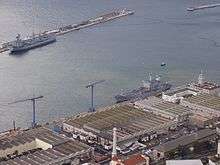
Gibraltar's defence is the responsibility of the United Kingdom tri-services British Forces Gibraltar. In January 2007, the Ministry of Defence announced that the private company Serco would provide services to the base. The announcement resulted in the affected trade unions striking.
- The Royal Gibraltar Regiment provides the army garrison with a detachment of the British Army, based at Devils Tower Camp.[113] The regiment was originally a part-time reserve force until the British Army placed it on a permanent footing in 1990. The regiment includes full-time and part-time soldiers recruited from Gibraltar as well as British Army regulars posted from other regiments.
- The Royal Navy maintains a squadron at the Rock. The squadron is responsible for the security and integrity of British Gibraltar Territorial Waters (BGTW). The shore establishment at Gibraltar is called HMS Rooke after Sir George Rooke who captured the Rock for Archduke Charles (pretender to the Spanish throne) in 1704. The naval air base was named HMS Cormorant. Gibraltar's strategic position provides an important facility for the Royal Navy and Britain's allies. British and US nuclear submarines frequently visit the Z berths at Gibraltar.[114] A Z berth provides the facility for nuclear submarines to visit for operational or recreational purposes and for non-nuclear repairs. During the Falklands War, an Argentine plan to attack British shipping in the harbour using frogmen (Operation Algeciras) was foiled.[115] The naval base also played a part in supporting the task force sent by Britain to recover the Falklands.
- The Royal Air Force station at Gibraltar forms part of Headquarters British Forces Gibraltar. Although aircraft are no longer permanently stationed at RAF Gibraltar, a variety of RAF aircraft make regular visits and the airfield also houses a section from the Met Office.
Gibraltar has an important role in UKSIGINT and provides a vital strategic part of the United Kingdom communications gathering and monitoring network in the Mediterranean and North Africa.
International relations
Gibraltar is twinned with:
| City | State/Region | Country |
|---|---|---|
| Ballymena | ||
| Funchal | ||
| Singapore | ||
| Gibraltar |
See also
Footnotes
- Notes
- ↑ Station ID for Gibraltar is 08495 Use this station ID to locate the sunshine duration
- ↑ Despite several sites reporting that tag rugby was invented by Perry Haddock in Australia around 1990 (this is OzTag, a variant of Tag Rugby), Godwin's wrote about the topic seven years prior. Godwin does not mention when the sport began on Gibraltar, but he does explicitly use the term "Tag Rugby" to describe the game.
- References
- ↑ "National Symbols". Gibraltar.gov.gi. Retrieved 21 June 2013.
- ↑ "Gibraltar: National anthem". CIA World Factbook. Central Intelligence Agency. Retrieved 25 September 2011.
National anthem: name: "Gibraltar Anthem" . . . note:adopted 1994; serves as a local anthem; as a territory of the United Kingdom, "God Save the Queen" remains official (see United Kingdom)
- ↑ Gibraltar was captured on 24 July 1704 Old Style or 4 August 1704 New Style.
- ↑ The treaty was signed on 31 March 1713 Old Style or 11 April 1713 New Style (Peace and Friendship Treaty of Utrecht between France and Great Britain).
- ↑ Quality of Life, Balance of Powers, and Nuclear Weapons (2015) Avakov, Aleksandr Vladimirovich. Algora Publishing, 1 Apr 2015.
- ↑ Universal Postal Union document on Gibraltar
- ↑ Dictionary Reference: Gibraltar
- ↑ The Free Dictionary: Gibraltar
- ↑ Statistics Office (2009). "Abstract of Statistics 2009" (PDF). Statistics Office of the Government of Gibraltar. p. 2. The civilian population includes Gibraltarian residents, other British residents (including the wives and families of UK-based servicemen, but not the servicemen themselves) and non-British residents. Visitors and transients are not included.
In 2009, this broke down into 23,907 native-born citizens, 3,129 UK British citizens and 2,395 others, making a total population of 29,431. On census night, there were 31,623 people present in Gibraltar. - ↑ Foreign and Commonwealth Office. "Country Profiles: Gibraltar"., Foreign and Commonwealth Office, 6 May 2010; retrieved 16 April 2015
- 1 2 (Spanish) Informe sobre la cuestión de Gibraltar, Spanish Foreign Ministry. Archived 25 March 2010 at the Wayback Machine.
- ↑ Hills, George (1974). Rock of Contention: A history of Gibraltar. London: Robert Hale & Company. p. 13. ISBN 0-7091-4352-4.
- ↑ Choi, Charles (2006). "Gibraltar". MSNBC. Retrieved 8 January 2010.
- ↑ Norris, H.T. (1961). "The Early Islamic Settlement in Gibraltar". Journal of the Royal Anthropological Institute of Great Britain and Ireland. 91: 39–51. doi:10.2307/2844467. JSTOR 2844467.
- ↑ "The History of Gibraltar and of Its Political Relation to Events in Europe, From the Commencement of the Moorish Dynasty in Spain to the Last Morocco War". Mocavo.
- ↑ Maurice Harvey (1996). Gibraltar. A History. Spellmount Limited. pp. 50–51. ISBN 1-86227-103-8.
- ↑ Lamelas Oladán, Diego (1 April 1990). "Asentamiento en Gibraltar en 1474 y expulsión en 1476" (PDF). Almoraima. Revista de Estudios Campogibraltareños (in Spanish). Instituto de Estudios Gibraltareños (3 (Suplemento 'La compra de Gibraltar por los conversos andaluces (1474–1476)')): 25.
- ↑ William Jackson (1990). The Rock of the Gibraltarians. A History of Gibraltar (Second ed.). Grendon, Northamptonshire, United Kingdom: Gibraltar Books. p. 101. ISBN 0-948466-14-6.
- ↑ Stephen Constantine (2009). Community and identity. The making of modern Gibraltar since 1704. Manchester University Press. p. 15. ISBN 978-0-7190-8054-8.
- ↑ William Godfrey Fothergill Jackson (1990). The Rock of the Gibraltarians: A History of Gibraltar. Gibraltar Books. p. 257. ISBN 978-0-948466-14-4. Retrieved 18 April 2011.
- ↑ Cahoon, Ben (2000). "Gibraltar". WorldStatesmen. Retrieved 20 December 2007.
- ↑ "Regions and territories: Gibraltar". British Broadcasting Corporation. 18 July 2007. Retrieved 20 December 2007.
- ↑ Mark Oliver; Sally Bolton; Jon Dennis; Matthew Tempest (4 August 2004). "Gibraltar". The Guardian. London. Retrieved 20 December 2007.
- ↑ Corrected transcript of evidence taken before the Foreign Affairs Select Committee; 28 March 2008; Answer to Question 257 by Jim Murphy: [T]he UK Government will never – "never" is a seldom-used word in politics – enter into an agreement on sovereignty without the agreement of the Government of Gibraltar and their people. In fact, we will never even enter into a process without that agreement. Archived 3 March 2016 at the Wayback Machine.
- ↑ "World Factbook". CIA. Retrieved 15 June 2010.
- ↑ Williams, Jennifer (2016-06-24). "The Brexit vote result has reignited a 300-year-old fight between Britain and Spain". Vox. Retrieved 2016-06-26.
- ↑ "Spain would demand control of Gibraltar the 'next day after Brexit'". Retrieved 2016-06-26.
- ↑ "EU referendum: Who are the Gibraltar 823? – BBC News". Retrieved 2016-06-26.
- ↑ "Brexit: Spain calls for joint control of Gibraltar – BBC News". Retrieved 2016-06-26.
- ↑ Parliament.uk, UK House of Commons Foreign Affairs Committee 2007–2008 Report, pg 16
- ↑ Telegraph.co.uk, David Blair, Gibraltar makes plans for self-government, Daily Telegraph, 28 February 2002 "GIBRALTAR'S parliament approved an ambitious package of constitutional reform yesterday designed to give the colony almost complete self-government."
- ↑ "Gibraltar". Encyclopædia Britannica. Retrieved 18 August 2009.
Gibraltar is an overseas territory of the United Kingdom and is self-governing in all matters but defence.
- ↑ "Laws of Gibraltar – On-line Service". Gibraltarlaws.gov.gi. Retrieved 13 May 2011.
- ↑ "The Gibraltar Parliament". Gibraltar.gov.gi. Archived from the original on 24 March 2010. Retrieved 13 May 2011.
- ↑ TheCommonwealth.org, The Secretariat of the Commonwealth: "The governor represents the British monarch who is head of state and retains direct responsibility for all matters not specifically allocated to local ministers: principally external affairs, defence and internal security" Archived 5 September 2013 at the Wayback Machine.
- ↑ PriceWaterhouseCoopers, "About Gibraltar"
- ↑ GPA.gi, Gibraltar Police Authority, About the Gibraltar Police Authority – Other Duties and Responsibilities – Accountability: "1. to be accountable to the Governor on policing aspects of national security including internal security (section 12); 2. to be accountable to the Government for those parts of the Annual Policing Plan which do not relate to national security (section 15)." Archived 4 May 2012 at the Wayback Machine.
- ↑ Gibraltar.gov.gi, Gibraltar Chief Minister's address at the United Nations Committee of 24 on 5 June 2007: The new Constitution "maximises self Government in all areas of Governance except defence, external affairs and internal security which, under our own Constitution vest in the Governor as a matter of distribution of powers."
- 1 2 BBC News website, Regions and territories: Gibraltar "Gibraltar is self-governing in all areas except defence and foreign policy."
- ↑ Legco.gov.hk, Page 6, "Lords of Appeal in Ordinary in the House of Lords are appointed by the Queen on the recommendation of the Prime Minister, but the Lord Chancellor's opinion is generally sought. This method of appointment is a matter of practice and convention, not of written law."
- ↑ The Committee Office, House of Commons. "Statement by the Minister for Europe". Publications.parliament.uk. Retrieved 13 May 2011.
- ↑ "Gibraltar should join South West for elections to European Parliament". Electoral Commission. 28 August 2003. Archived from the original on 5 December 2007. Retrieved 20 December 2007.
- ↑ Withnall, Adam (23 June 2016). "Gibraltar overwhelmingly backs Remain in first result of the night". The Independent. Independent Digital News & Media. Retrieved 23 June 2016.
- ↑ "Gibraltar Profile" (PDF). UN. Retrieved 6 November 2016.
- ↑ "Gibraltar Territorial status" (PDF). United Nations Committee on Decolonization. Retrieved 28 June 2014.
- ↑ Gibraltar: Time to get off the fence; Second Report of Session 2014–15; HC 461. Great Britain: Parliament: House of Commons: Foreign Affairs Committee. Paragraph 83, p. 46
- ↑ Parliament.uk, UK House of Commons Foreign Affairs Committee 2007–2008 Report, pg 5
- ↑ "Gibraltar Water Supply". AquaGib. Archived from the original on 10 November 2007. Retrieved 20 December 2007.
- ↑ "Visit Gibraltar – Upper Rock". Retrieved 9 January 2014.
- ↑ CIA Factbook – Geographic location
- ↑ The Maltese Islands, Department of Information – Malta.
- ↑ "Gibraltar Climate Guide". Retrieved 5 June 2009.
- ↑ "Klimatafel von Gibraltar / Großbritannien" (PDF). Baseline climate means (1961-1990) from stations all over the world (in German). Deutscher Wetterdienst. Retrieved 29 September 2016.
- ↑ "Station 08495 Gibraltar". Global station data 1961–1990—Sunshine Duration. Deutscher Wetterdienst. Retrieved 29 September 2016.
- ↑ C. Michael Hogan (2008) Barbary Macaque: Macaca sylvanus, Globaltwitcher.com, ed. Nicklas Stromberg Archived 19 April 2012 at the Wayback Machine.
- ↑ Casciani, Dominic (22 July 2004). "Churchill sends telegram to protect apes". BBC News. Retrieved 13 May 2011.
- ↑ Bruno Waterfield Whitehall gaffe 'gives Gibraltar's shores to Spain. The Daily Telegraph (London), 7 November 2009
- ↑ "Ambient (outdoor) air pollution database, by country and city 2016 – Excel format". Retrieved 2016-05-25.
- ↑ "Europe. Gibraltar (British Overseas Territory)". Foreign and Commonwealth Office. 21 August 2012. Archived from the original on 27 September 2012. Retrieved 9 December 2012.
- ↑ "Tax Information". Government of Gibraltar. Archived from the original on 28 April 2012. Retrieved 9 May 2011.
- ↑ "Microsoft Word – 1983-13o.doc" (PDF). Retrieved 26 March 2013.
- ↑ "Financial Services Commission". Fsc.gi. Retrieved 13 May 2011.
- ↑ "Microsoft Word – 2007-03o.doc" (PDF). Retrieved 26 March 2013.
- ↑ Moran Harari, Markus Meinzer and Richard Murphy (October 2012) "Financial Secrecy, Banks and the Big 4 Firms of Accountants" Tax Justice Network pages 21–24
- ↑ European Central Bank Monthly Bulletin, April 2006, page 96
- 1 2 "Currency Notes Act, Section 6" (PDF). Government of Gibraltar. 11 May 1934. Retrieved 20 December 2007.
- ↑ Managing a Global Enterprise, William R. Feist, James A. Heely, Min H. Lu, page 40
- ↑ Currency Board Arrangements, Tomás J. T. Baliño, Charles Enoch, International Monetary Fund, page 1
- ↑ Madge, A; A. Simons (June 2000). "Gibraltar". Guardian International Currency Corp. Archived from the original on 11 October 2007. Retrieved 20 December 2007.
- ↑ Noble, John; Forsyth, Susan; Hardy, Paula; Hannigan, Des (2005). Andalucía. Lonely Planet. p. 221. ISBN 978-1-74059-676-3.
- ↑ Statistics Office, Government of Gibraltar: Abstract of Statistics Report 2011
- ↑ Archer, Edward G.: Gibraltar, identity and empire. Routledge Advances in European Politics
- 1 2 3 4 5 https://www.gibraltar.gov.gi/new/sites/default/files/HMGoG_Documents/Full%20Census%20Report%202012%20FINAL.pdf
- 1 2 Gibraltar Census History Archived 14 November 2013 at the Wayback Machine.
- ↑ "Culture of Gibraltar". Everyculture. Retrieved 5 October 2007.
- ↑ Anja Kellermann (2001). A New New English: Language, Politics, and Identity in Gibraltar. BoD – Books on Demand. pp. 9–. ISBN 978-3-8311-2368-1.
- ↑ http://www.gibraltar.gov.gi/images/stories/PDF/statistics/Census/census_of_gibraltar_2001.pdf
- ↑ "Gibraltar Methodist Church". The Methodist Church. Retrieved 30 October 2007.
- ↑ "2001 Census" (PDF). Official Government of Gibraltar London website. Retrieved 10 April 2012.
- ↑ "Minister Licudi announces the adoption of the University of Gibraltar Act".
- ↑ "University of Gibraltar".
- ↑ "Education & Training". Government of Gibraltar. 7 April 2003. Archived from the original on 2 March 2001. Retrieved 20 December 2007.
- ↑ "Gibraltar Health". TravelPuppy. Retrieved 20 December 2007.
- ↑ "Gibraltar ends annual balloon release on environmental grounds". Guardian News and Media Limited or its affiliated companies. The Guardian. April 2016. Retrieved 7 July 2016.
- ↑ "Be a part of history in the Gibraltar Diamond Jubilee Flotilla". Home and Lifestyle Magazine. 16 May 2012. Retrieved 17 August 2012.
- ↑ "Gibraltar: Fact File". Birmingham UK International Directory – Gibraltar. Retrieved 31 August 2007.
- ↑ Yborra Aznar, José Juan (2004). "La ciudad perdida: Gibraltar en la obra de Héctor Licudi". Eúphoros (in Spanish) (7): 317–326. ISSN 1575-0205.
- ↑ Mascarenhas, Alice. "Always a Pleasure to Perform in Gibraltar". The Gibraltar Chronicle. Archived from the original on 28 September 2007. Retrieved 20 December 2007.
- ↑ "Newsletter No 70" (PDF). Friends of Gibraltar Heritage Society. November 2004. Archived from the original (PDF) on 1 December 2007. Retrieved 30 March 2015.
- ↑ "Gibraltar fail to get Uefa place". BBC Sport. 26 January 2007.
- ↑ "Gibraltar played in the qualifying program for the 2016 European Championship.".
- ↑ "Gibraltar given full Uefa membership at London Congress". BBC Sport. 24 May 2013.
- ↑ "CAS UPHOLDS THE APPEAL FILED BY THE GIBRALTAR FOOTBALL ASSOCIATION REGARDING ITS REQUEST TO BECOME A FULL MEMBER OF FIFA" (PDF).
- ↑ Godwin, Terry (1983). The Guinness Book of Rugby Facts & Feats (2nd ed.). Enfield: Guinness Superlatives Ltd. p. 186. ISBN 0-85112-264-7.
- ↑ "Communiqué of the ministerial meeting of the forum of dialogue on Gibraltar" (PDF). Government of Gibraltar. 18 September 2006. Archived from the original (PDF) on 22 March 2007. Retrieved 17 October 2008.
- ↑ Government of Gibraltar (18 September 2006). "Trilateral Forum. Ministerial Statement on Pensions". Archived from the original (PDF) on 24 February 2010. Retrieved 17 October 2008.
- ↑ "Press Release. Airport Agreement" (PDF). Government of Gibraltar. 18 September 2006. Archived from the original (PDF) on 24 November 2007. Retrieved 17 October 2008.
- ↑ "Spain restores Gibraltar air link". British Broadcasting Corporation. 16 December 2006. Retrieved 20 December 2007.
- ↑ Government of Gibraltar. "Press Release: Government of Gibraltar Reaction to GB Sale". Archived from the original (PDF) on 24 February 2010. Retrieved 16 October 2008.
- ↑ "Regional Andalusia airline begins Gibraltar-Madrid airbridge". MercoPress. Retrieved 9 March 2010.
- ↑ "Andalus drops Gibraltar". Panorama.gi. Retrieved 13 May 2011.
- ↑ Government of Gibraltar. "Press Release: New Air Terminal, tunnel under the runway and new road leading to all parts of Gibraltar north of the runway". Archived from the original (PDF) on 24 February 2010. Retrieved 17 October 2008. and images of the proposals: "Press Release: New Terminal Building" (PDF). Archived from the original (PDF) on 29 October 2008. Retrieved 17 October 2008.
- ↑ "The Chief Minister presented the plans for an ambitious new terminal building for Gibraltar Airport". 7 Days Gibraltar. Retrieved 21 December 2007.
- ↑ The Committee Office, House of Commons. "Frontier restrictions". Publications.parliament.uk. Retrieved 13 May 2011.
- ↑ Scotsman.com News: Spanish seal border as virus ship docks. Retrieved 16 October 2007
- ↑ "Fishermen block frontier". Panorama.gi. Retrieved 13 May 2011.
- ↑ New ferry 'repairs 40 year gap' says Spanish Diplomat, Gibraltar Chronicle, 17 December 2009
- ↑ "La Línea lleva más de ochenta años esperando que pase el primer...". europasur.es.
- ↑ Andalusia. "Google Maps coordinates". Google Maps. Retrieved 16 August 2013.
- ↑ "Morocco Travel Information – Information About Traveling in Morocco". Goafrica.about.com. 6 September 2012. Retrieved 9 December 2012.
- ↑ The Man in Seat 61... "How to travel by train London to Morocco | Train travel in Morocco". Seat61.com. Retrieved 9 December 2012.
- ↑ Judiciary and Law – Police, Gibraltar Government Website https://www.gibraltar.gov.gi/judiciary-a-law?start=2
- ↑ "HIVE Location overview – Gibraltar". Ministry of Defence. December 2007. Archived from the original (PDF) on 24 February 2010. Retrieved January 2010. Check date values in:
|access-date=(help) - ↑ "House of Commons Hansard Written Answers". Parliament of the United Kingdom. 9 November 1999. Retrieved 20 December 2007.
- ↑ Giles Tremlett (24 July 2004). "Falklands war almost spread to Gibraltar". The Guardian. London. Retrieved 9 December 2012.
Bibliography
- Abulafia, David (2011). The Great Sea: A Human History of the Mediterranean. London: Allen Lane. ISBN 978-0-7139-9934-1.
- Bond, Peter (2003). "Gibraltar's Finest Hour The Great Siege 1779–1783". 300 Years of British Gibraltar 1704–2004 (1st ed.). Gibraltar: Peter-Tan Publishing Co. pp. 28–29.
- Chartrand, René (July 2006). Gibraltar 1779–1783: The Great Siege. Patrice Courcelle (1st ed.). Gibraltar: Osprey Publishing. ISBN 978-1-84176-977-6. Archived from the original on 27 September 2007.
- Drinkwater, John: A history of the siege of Gibraltar, 1779–1783: With a description and account of that garrison from the earliest periods London, 1862.
- Falkner, James: FIRE OVER THE ROCK: The Great Siege of Gibraltar 1779–1783, Pen and Sword, 2009
- Harvey, Robert: A Few Bloody Noses: The American War of Independence, London, 2001
- Rodger, N. A. M.: The Command of the Ocean: A Naval History of Britain, 1649–1815, London, 2006
- Norwich, John Julius: The Middle Sea: a history of the Mediterranean, Random House, 2006
- Sugden, John: Nelson: A Dream of Glory, London, 2004
- Syrett, David: Admiral Lord Howe: A Biography, London, 2006.
- Maria Monti, Ángel: Historia de Gibraltar: dedicada a SS. AA. RR., los serenisimos señores Infantes Duques de Montpensier, Imp. Juan Moyano, 1852
- Maria Montero, Francisco: Historia de Gibraltar y de su campo, Imprenta de la Revista Médica, 1860
- Uxó Palasí, José: Referencias en torno al bloqueo naval durante los asedios, Almoraima. n.º 34, 2007
External links
- Interactive Map of Gibraltar
- Government of Gibraltar
- Photo of Gibraltar
- Royal Gibraltar Police
- Gibraltar Fire & Rescue Service
 |
|
|
Mediterranean Sea |  |
| Bay of Gibraltar |
|
Mediterranean Sea | ||
| ||||
| | ||||
| Strait of Gibraltar |
Strait of Gibraltar |
Mediterranean Sea |
Coordinates: 36°8′28.48″N 5°20′50.53″W / 36.1412444°N 5.3473694°W
